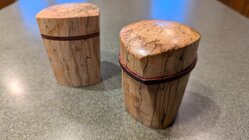When we use the expression ‘I turned a box’ what is the accepted definition of a “box”?
-
June 2025 Turning Challenge: Turn a Wand! (click here for details) -
Congratulations to Dave Landers for "Pod Box" being selected as Turning of the Week for June 2, 2025 (click here for details) -
Welcome new registering member. Your username must be your real First and Last name (for example: John Doe). "Screen names" and "handles" are not allowed and your registration will be deleted if you don't use your real name. Also, do not use all caps nor all lower case.
You are using an out of date browser. It may not display this or other websites correctly.
You should upgrade or use an alternative browser.
You should upgrade or use an alternative browser.
Box Definition
- Thread starter Bernie Kopfer
- Start date
Dave Landers
Beta Tester
For me: You can put something in it, and it has a lid of some sort.
as a newbie, I didn’t at first understand it was round. Hollowed with a top, exactly.
I would say a container with a lid, generally turned end grain so the lid remains well fitting. If the container is turned face grain/cross grain, then I would call it a lidded bowl. I don't believe there is universally agreed upon terminology, though.
I think that there are definetly lidded cross grain boxes. Bowl to me has a curved bottom. If we look at the cross grain box for the February challenge from Richard Raffan, that is definetly a box. I do agree it can be ambiguous of course.I would say a container with a lid, generally turned end grain so the lid remains well fitting. If the container is turned face grain/cross grain, then I would call it a lidded bowl. I don't believe there is universally agreed upon terminology, though.
Gregory
- Joined
- Apr 27, 2004
- Messages
- 9,213
- Likes
- 5,840
- Location
- Lakeland, Florida
- Website
- www.hockenberywoodturning.com
Good answers
ChatGPT had this to say
A turned box is a small, lidded container made on a lathe, usually from wood but sometimes from other materials like acrylic or resin. The process of turning involves shaping the box and lid by spinning the material on a lathe and using cutting tools to achieve the desired form. Turned boxes are often used for holding small items like jewelry, keepsakes, or spices.
A lidded bowl is a bowl with a fitted lid, typically used for storage, serving food, or decorative purposes. It can be made from various materials like ceramic, wood, glass, or metal. The lid may sit loosely or fit tightly, depending on its design and intended use.
ChatGPT had this to say
A turned box is a small, lidded container made on a lathe, usually from wood but sometimes from other materials like acrylic or resin. The process of turning involves shaping the box and lid by spinning the material on a lathe and using cutting tools to achieve the desired form. Turned boxes are often used for holding small items like jewelry, keepsakes, or spices.
A lidded bowl is a bowl with a fitted lid, typically used for storage, serving food, or decorative purposes. It can be made from various materials like ceramic, wood, glass, or metal. The lid may sit loosely or fit tightly, depending on its design and intended use.
Dave Landers
Beta Tester
The difference between a box and a lidded bowl is ... what the maker (or owner) calls it.
Bernie, good question!When we use the expression ‘I turned a box’ what is the accepted definition of a “box”?
Basically, a turned box is simply a round, hollowed piece with a lid. Beyond that, there are opinions.
To me, the grain orientation doesn't matter - end grain, face (side) grain, or even from a blank cut at a 45-deg angle!
If I call it a box, it's a box (to me). Doesn't matter to me if someone calls it something else.
One thing about grain orientation: Due to the way wood moves with moisture change, say from the seasons, an end-grain box, made with the grain running parallel to the bed of the lathe, is far more likely to stay round and stable with seasonal humidity changes. Boxes made from side grain, face orientation, are more likely to go out of round, some so much that an otherwise non-sticking lid can start sticking! The amount they go out of round can depend on factors such as the type of wood and how well and what the wood is sealed with, as well, of course, as the degree of humidity change in the environment.
The lid can be tight, as woodturners are sometimes taught to make, so it makes a "pop" when opened - mostly to impress other woodturners. These take two hands to open. People who use boxes for jewelry, for stamps, paper clips, in the kitchen and such like a box where the lid can be removed with one hand. If you want to annoy someone who otherwise likes you, just make them a jewelry box that needs two hands to open!
What I increasingly do for side grain boxes (and end grain boxes) is make lids with tapered fittings. This makes the lid looser and can completely eliminate sticking with seasonal changes.
However, there is a good reason to make some boxes with tight lids - those used where you don't want the lid to come off accidentally!
Below are pictures of a few boxes I've made over the years. ALL of these are end-grain boxes, turned with the grain running parallel to the lathe bed and headstock spindle. Some have tapered fit lids.
The little boxes in the upper right photo can be used as needle cases, to hold pills, etc. Carried in a pocket or bag, the lids need to stay on so I made them with long, straight fittings, snug but not tight. The one on the lower right is a music box. The three black&white ebony boxes have threaded lids.

For those who don't know, lots of woodturners (and flatwood workers) make Beads Of Courage boxes. These are made and donated to children's hospitals. Under the Beads of Courage program kids with serious illnesses, usually cancer, are given a bead for every procedure, a needle stick, loss of hair from chemo, etc. Some have hundreds of beads and keep them on long strings. The boxes are a way to keep the strings of beads and let them get them out to tell their story.
Since some kids have limited mobility, it's important that the boxes are easy to open. I once went to a turning symposium where 10 boxes had been turned in - I found that 5 of the 10 had lids that were stuck closed!! A local BOC coordinator said he had to fix a lot of the donated boxes so the lids would open easily. For this reason, I teach making tapered lids on all BOC boxes. Not only will they never stick, the lid can be placed on the box easily by small hands!
Here are some of the Beads of Courage boxes I've made. All have tapered lids. Since they have to be relatively large volume and are best made with dry wood, I make most with layers of thick dry lumber. This makes them face grain, more likely to go out of round with the seasons, I think the tapered lids are important.
The one in the upper right is an end-grain box made from a singe large tulip poplar blank I dried for years before use. I built a music box into the lid.
All the others are side-grain boxes made from glued up layers cut from dry lumber.
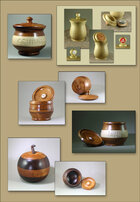
Note that depending on the shape and function, I might not think of a turning with a lid as a box.
For example, this one I think of as a lidded "vessel". Eastern Red Cedar.
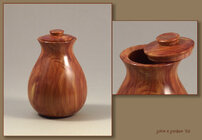
And although these have lids, only the top part is hollowed and with the slightly narrowed necks I think of them as lidded goblets!
These are "profile" turnings, I made using the face profiles of my son and his wife (perhaps easier to see on the right sides. (I wish I had taken better care with the lighting...) I make these by enlarging a profile photo in Photoshop, print, then cut out a card stock template.

JKJ
Last edited:
End grain orientation verse's face grain can have the same issues especially if the pith is not included, since the same radial and tangential shrinkage rates are present. End grain with the pith included may not go out of round as much, but the overall diameter can & will change with the seasons causing the binding.One thing about grain orientation: Due to the way wood moves with moisture change, say from the seasons, an end-grain box, made with the grain running parallel to the bed of the lathe, is far more likely to stay round and stable with seasonal humidity changes. Boxes made from side grain, face orientation, are more likely to go out of round, some so much that an otherwise non-sticking lid can start sticking! The amount they go out of round can depend on factors such as the type of wood and how well and what the wood is sealed with, as well, of course, as the degree of humidity change in the environment.
You are correct. Instead of "far more likely to stay round and stable" perhaps I should have added "depending on the species, the specific tree and how it grew, where the end grain blank is cut from the tree, the size of the box blank, and other factors"End grain orientation verse's face grain can have the same issues especially if the pith is not included, since the same radial and tangential shrinkage rates are present. End grain with the pith included may not go out of round as much, but the overall diameter can & will change with the seasons causing the binding.
And all bets are off with reaction wood from a limb. Look at this oak limb with nearly 100 rings, from one of my trees near the barn:
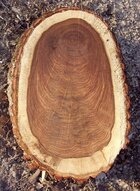
It was my favorite limb - about 40' long, maybe 8' from the ground, and almost exactly horizontal for the first 30'.
Sadly, the rest of the tree came down a few years later after a rain. Dented my pasture fence...
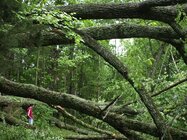
Took me hours to clean up with my tractor and small chainsaw. Ok, almost a week.
JKJ
Apparently ChatGPT has not figured out if grain orientation is involved in the definition of a box, but recognizes there is a difference between a bowl and a box, but is unable to accurately say what that difference is. To define the difference by usage and not by appearance tells me that we woodturners are still one up. Probably not for long.Good answers
ChatGPT had this to say
A turned box is a small, lidded container made on a lathe, usually from wood but sometimes from other materials like acrylic or resin. The process of turning involves shaping the box and lid by spinning the material on a lathe and using cutting tools to achieve the desired form. Turned boxes are often used for holding small items like jewelry, keepsakes, or spices.
A lidded bowl is a bowl with a fitted lid, typically used for storage, serving food, or decorative purposes. It can be made from various materials like ceramic, wood, glass, or metal. The lid may sit loosely or fit tightly, depending on its design and intended use.
Apparently ChatGPT has not figured out....
I gave up reading anything the so called AI algorithms output. Some was obviously incorrect. I suspect everything written here and elsewhere is copied, parsed, stored, then searched, voted on,and a compilation regurgitated.
I have heard about not using the branches for turning bowls or other things because of "tension". Well, the way I look at it, if you rough turn it, that removes most of the tension. The good thing about tension wood is the figure. I got a branch from a big leaf maple tree a few years back, and it was growing straight horizontal. It looked like that section John shows up above, pith on top about 3 inches from the top and most of the branch underneath. It had incredible figure/ripple through the whole 10 foot length. I have had box blanks drying for about 2 years now, time to finish them up. since they have been roughed out, I figure most of that stress has been removed. With my bowls I turned from it, the more they warp, the more I like them!
robo hippy
robo hippy
The reaction wood may be neutralized but the thing we call figure will affect how the seasonal changes affect the confusion of radial and tangential movement on a box with a close fitting lid. The seasonal movement of a bowl will be unnoticeable as long as it can move without checking.I have had box blanks drying for about 2 years now, time to finish them up. since they have been roughed out, I figure most of that stress has been removed. With my bowls I turned from it, the more they warp, the more I like them!
Last edited:
Hmmm...... I've been cleaning my shop. I put a bunch of stuff in grocery store "boxes" without lids to take to the dump.
My wife has a couple jewelry "boxes" I made for her when we first bought a house with workshop space. Flat grain, unturned rectangular "boxes" with lids.
I've made small turned "containers" with screw-on lids. Also made what look like turned "boxes" on the CNC without doing any of what the AAW defines as turning.
My wife has a couple jewelry "boxes" I made for her when we first bought a house with workshop space. Flat grain, unturned rectangular "boxes" with lids.
I've made small turned "containers" with screw-on lids. Also made what look like turned "boxes" on the CNC without doing any of what the AAW defines as turning.
I gave up reading anything the so called AI algorithms output. Some was obviously incorrect. I suspect everything written here and elsewhere is copied, parsed, stored, then searched, voted on,and a compilation regurgitated.
I once googled something like, "what is 200 ounces of gold worth?" The answer was off by one zero. If the answer was $500k, the AI said $50k. That's about as bad as it gets.
I wouldn't trust AI for anything that changes with time, the model is based on old information. Also, anything dealing with math and programming should be heavily scrutinized since hallucinations are frequent and can greatly change the outcome. Generative AI doesn't actually look up information, it just makes a string of words that looks plausible based on the training data and your prompt.
Just got this advice from google ai on how to get a CBN wheel to run perfectly true. It told me to true it with a diamond wheel dresser. Not just wrong, but damaging and probably dangerous. This is why I don’t trust it for anything.

